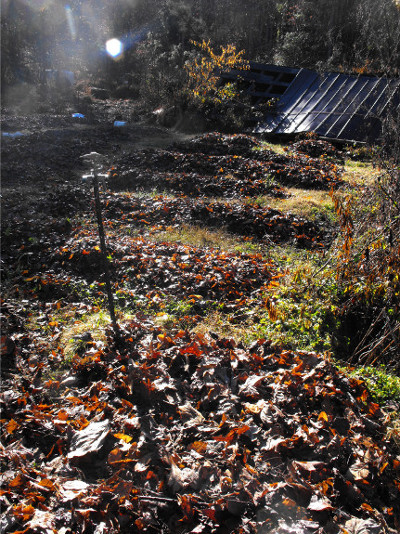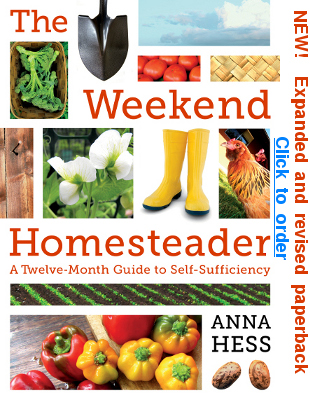
Urban biomass
 The
typical city or town
is so full of biomass going to waste that you could spend all day
harvesting. In addition to the materials listed in the last
section, you'll find:
The
typical city or town
is so full of biomass going to waste that you could spend all day
harvesting. In addition to the materials listed in the last
section, you'll find:
Coffee
grounds are
produced in
large quantities at coffee shops. Grounds are seed-free and high
in nitrogen (C:N of 12:1) so they can be used straight in the garden or
in the worm bin.
Cardboard looks like it should
be lower in quality than paper, but the corrugated version is bound
together with biodegradable glues that soil microorganisms love.
I can never get enough corrugated cardboard for making kill mulches,
but if I had excess I would tear it up and use it as worm bin bedding
or in the compost pile. Corrugated cardboard can also be used to
propagate
edible mushrooms.
Most stores have cardboard boxes to give away, but furniture stores
will have the largest boxes that are best for kill mulches.
 Tree leaves are one of my
favorite curb-side attractions in the fall. Their C:N ratio of
around 50:1 (and lack of seeds) makes deciduous tree leaves a good
source of mulch, especially if you can find a way to shred the leaves
so that they don't blow away. Since trees suck up micronutrients
from deep in the earth, their leaves are rich in elements like calcium
that your soil may be lacking. To compost leaves, shred them if
possible and then mix with a higher nitrogen material like manure.
Tree leaves are one of my
favorite curb-side attractions in the fall. Their C:N ratio of
around 50:1 (and lack of seeds) makes deciduous tree leaves a good
source of mulch, especially if you can find a way to shred the leaves
so that they don't blow away. Since trees suck up micronutrients
from deep in the earth, their leaves are rich in elements like calcium
that your soil may be lacking. To compost leaves, shred them if
possible and then mix with a higher nitrogen material like manure.
Spent hops and mash are a waste product of microbreweries.
These wet, high nitrogen materials are best added to a compost pile
with dry, high carbon materials.
Fish
waste
can be found at seafood processors and canneries. Fish waste
stinks to high heaven, so you'll want to mix it into the ground or bury
it deep in a compost pile immediately, but the fish are high in
nitrogen and trace minerals.
Learn
about other fun, cheap, and easy fall projects in Weekend
Homesteader: October.
| This post is part of our Scavening Biomass lunchtime series.
Read all of the entries: |
Want more in-depth information? Browse through our books.
Or explore more posts by date or by subject.
About us: Anna Hess and Mark Hamilton spent over a decade living self-sufficiently in the mountains of Virginia before moving north to start over from scratch in the foothills of Ohio. They've experimented with permaculture, no-till gardening, trailersteading, home-based microbusinesses and much more, writing about their adventures in both blogs and books.
Want to be notified when new comments are posted on this page? Click on the RSS button after you add a comment to subscribe to the comment feed, or simply check the box beside "email replies to me" while writing your comment.

My property is surrounded by pine trees therefore along with the fallen leaves and in the grass there are pine needles in abundance. I try to pick certain areas to rake leaves and to collect grass clippings where there arent AS MUCH but there are still quite a lot of pine needles in my compost pile. I've read that there is problems with the pine needles lowering the PH making the soil more acidic. Should I worry too much about this?
Also i was thinking, do you think it would be necessary to shred the willow tree's leaves and trees with rather thin small leaves? In the event someone didn't have a lawn mower,shredder device,would that be practical? I'm mainly asking b/c i have a tree that drops very thin leaves on the driveway and the leaves resemble a willow tree's leaves(but im pretty sure its not). Haven't yet correctly identified the tree.
Thanks
If I had a lot of pine needles going to waste, I'd use them to mulch blueberries. Then it would be a good thing if they raised the pH. Alternatively, you could mix some wood ashes (or lime) in with the pine needles as they compost to raise the pH back up. I don't have specific data on how much using pine needles will change your pH.
It's not mandatory to shred leaves --- I use them unshredded all the time. They just tend to rot slower and blow around more if unshredded. What's more important than shape of the leaf is thickness and amount of tannins. Thin leaves that rot quickly (like willows, maples, etc.) seldom need to be shredded while thicker leaves that rot slowly (like oaks and beeches) could use the jumpstart they get from shredding.
Finally, if you don't have a shredder, chickens do an awfully good job of shredding up leaves used as bedding in their coop.
Hi, I'm an avid reader of your blog with it's abundance of usefull information. I live on a small farm in Denmark and am slowly converting the place to biodiversity and food producing areas. I have a fulltime job so it takes a while:-) I was wondering about the cardboard you use as killmulch witch sounds great but can you be sure it is free of nasty chemicals? ink glue etc.? same for newspaper?
Well as I have said i really enjoy the blog!
Christian